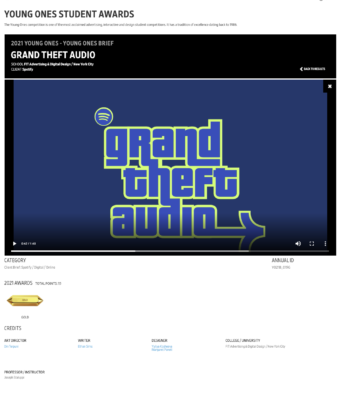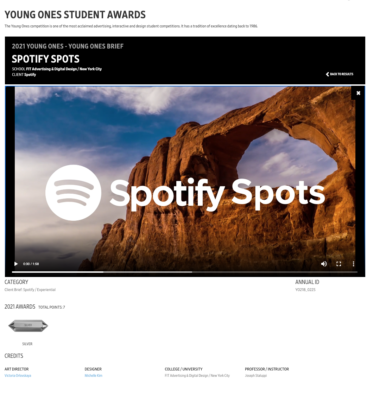
This year, FIT’s Advertising and Digital Design students won eight Young Ones awards from the One Club for Creativity, the preeminent professional association in the field. These awards included a Gold, Silver, and Bronze Pencil, which honor “big ideas paired with quality execution,” as well as an ADC Silver Cube, which symbolizes “meticulous craftsmanship, design, and innovation.”
Based on these wins, the One Club has ranked the Advertising and Digital Design program No. 5 in the U.S. and No. 10 in the world among similar programs in 23 countries—the highest ranking the college has received.
“The One Club competition is like the Academy Awards for advertising,” says Associate Professor Joseph Staluppi. “It’s a really big deal.”
Students could choose from a selection of briefs, for example, to promote Spotify’s Your Daily Drive playlists at a time when few were commuting. The Gold Pencil and ADC Silver Cube went to “Grand Theft Audio,” a tongue-in-cheek campaign to bring the playlist into the massively popular video game Grand Theft Auto. Students Din Terpuni, Ethan Sims, Yuliya Kosheeva, and Margaret Panoti created and executed the concept.

The Silver Pencil went to “Spotify Spots,” a campaign to install Your Daily Drive playlists in national parks and at lookout points across America, for road trippers to enjoy. Victoria Orlovskaya and Michelle Kim worked on that project.
Separately, in the New Blood awards, hosted by the British organization D&AD, Advertising and Digital Design student teams won two Wood Pencils, for a campaign promoting an e-waste recycling program (by Matthew Lafergola, Hasibul Islam, and Daniel Persaud) and a Spotify feature that connects listeners to lesser-known artists (by Hasibul Islam, Victoria Jeon and Emily Xia).
The students developed these entries in a course called Student Competition, taught by Staluppi, to prepare work for a range of industry competitions, which can help them land jobs when they graduate.
Staluppi believes this year’s success can be attributed to the Advertising and Digital Design program’s embrace of digital media. After a recent revamp of the curriculum (including a name change from Advertising Design), the program offers nine creative technology courses, including User Experience (UX) Design, Typography for Digital Content Design, and Digital Product Design. FIT was the first school to offer these courses in a BFA program. Students now graduate with a true 360-degree multimedia focus: digital, print, audio, and video.
“The new program really prepares them to do much better work, award-winning work,” Staluppi says, “on par with the top ten schools in the world.”
